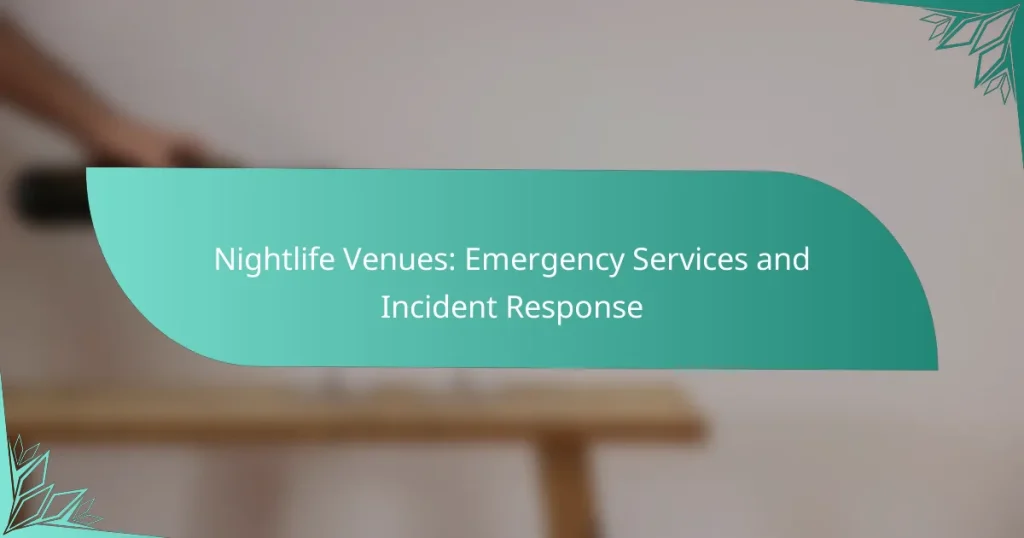Nightlife venues play a crucial role in ensuring the safety of patrons and staff by collaborating with emergency services such as local police, fire departments, and ambulance services. By developing comprehensive emergency response plans and training staff, these venues are equipped to handle various incidents, including altercations, medical emergencies, and fire hazards. Understanding the potential risks allows operators to create a safer environment for everyone involved.
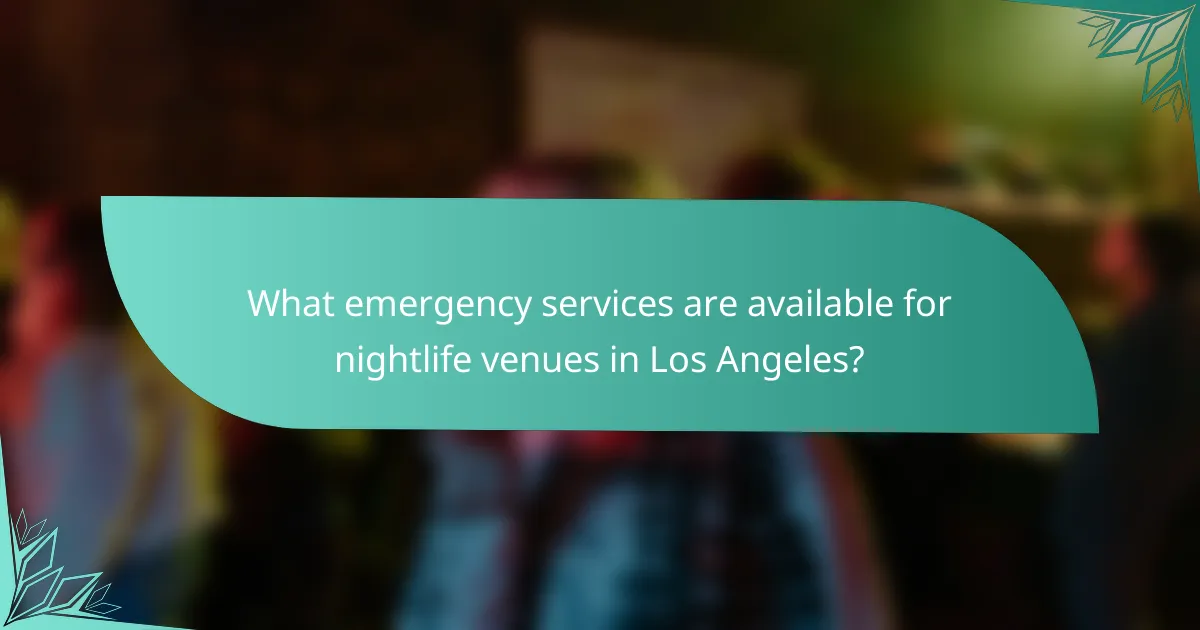
What emergency services are available for nightlife venues in Los Angeles?
In Los Angeles, nightlife venues have access to a range of emergency services, including local police, fire department, ambulance services, and private security. These services work together to ensure the safety and well-being of patrons and staff during events and busy nights.
Local police response teams
Local police response teams are crucial for maintaining order in nightlife venues. They are trained to handle various incidents, from minor disturbances to serious crimes. In Los Angeles, police can typically arrive on the scene within minutes, depending on the location and time of day.
Venues should establish a direct line of communication with local law enforcement. This can facilitate quicker responses and help staff understand when to involve police in incidents, ensuring a safer environment for everyone.
Fire department services
The Los Angeles Fire Department (LAFD) provides essential fire safety services to nightlife venues. They conduct inspections to ensure compliance with fire codes, which include proper exits, fire extinguishers, and crowd capacity limits. In case of an emergency, fire crews can respond rapidly to extinguish fires or assist with evacuations.
Venues should regularly review their fire safety plans and conduct drills with staff to ensure everyone knows evacuation routes and procedures. This preparation can significantly reduce panic and confusion during an actual emergency.
Ambulance and medical assistance
Ambulance services in Los Angeles are available to provide immediate medical assistance to patrons in need. The Los Angeles County Emergency Medical Services (EMS) can dispatch ambulances quickly, often within minutes. Venues should be aware of the nearest hospitals and have a plan for transporting individuals who require further medical attention.
It is advisable for nightlife venues to have trained first aid personnel on-site during events. This can help address minor injuries or health issues before they escalate and ensure that emergency services are contacted when necessary.
Security personnel and crowd management
Security personnel play a vital role in managing crowds and ensuring safety at nightlife venues. They are responsible for checking IDs, monitoring behavior, and addressing any disturbances before they escalate. In Los Angeles, hiring licensed security professionals is essential to comply with local regulations.
Effective crowd management strategies include clear signage, designated entry and exit points, and staff training on conflict resolution. Venues should regularly assess their security protocols to adapt to changing circumstances and ensure a safe environment for all attendees.

How do nightlife venues prepare for emergencies?
Nightlife venues prepare for emergencies by developing comprehensive strategies that include emergency response plans, staff training, and collaboration with local authorities. These preparations are essential for ensuring the safety of patrons and staff during unexpected incidents.
Emergency response plans
Emergency response plans outline the procedures that nightlife venues must follow in case of various emergencies, such as fires, medical incidents, or security threats. These plans typically include evacuation routes, communication protocols, and designated roles for staff members during an emergency.
Venues should regularly review and update their emergency response plans to reflect any changes in layout, staffing, or local regulations. This ensures that all personnel are familiar with the latest procedures and can act swiftly when needed.
Staff training and drills
Regular staff training and drills are crucial for effective emergency preparedness in nightlife venues. Training sessions should cover the specifics of the emergency response plan, including how to assist patrons and manage evacuations safely.
Drills should be conducted at least quarterly, allowing staff to practice their roles in a controlled environment. This not only builds confidence but also helps identify any gaps in the emergency response plan that need to be addressed.
Collaboration with local authorities
Collaboration with local authorities, such as fire departments and law enforcement, enhances the emergency preparedness of nightlife venues. Establishing relationships with these agencies allows venues to receive guidance on best practices and compliance with safety regulations.
Additionally, venues can invite local authorities to participate in training sessions or drills, fostering a better understanding of the venue’s layout and operations. This partnership can lead to quicker response times and more effective incident management during real emergencies.
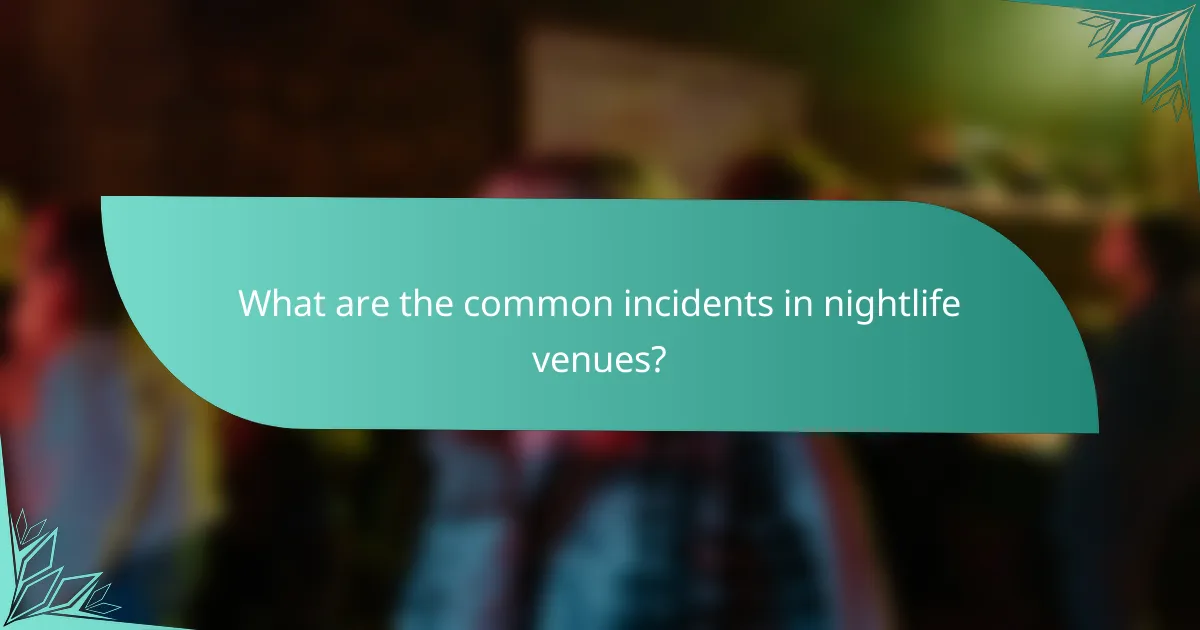
What are the common incidents in nightlife venues?
Common incidents in nightlife venues include altercations, medical emergencies, fire hazards, and overcrowding issues. Understanding these incidents helps venue operators prepare and respond effectively to ensure safety for patrons and staff.
Altercations and fights
Altercations and fights are frequent in nightlife settings, often triggered by alcohol consumption or misunderstandings. These incidents can escalate quickly, requiring immediate intervention from security personnel or law enforcement.
To mitigate risks, venues should implement clear policies regarding behavior, train staff in conflict resolution, and maintain a visible security presence. Establishing a zero-tolerance policy for violence can deter potential altercations.
Medical emergencies
Medical emergencies in nightlife venues can range from alcohol poisoning to injuries from falls or fights. Quick access to first aid and trained medical staff is crucial for effective response.
Venues should have a first aid kit readily available and staff trained in basic first aid and CPR. Establishing a clear protocol for contacting emergency services can save valuable time during critical situations.
Fire hazards
Fire hazards in nightlife venues can arise from overcrowding, faulty electrical systems, or improper use of flammable materials. Regular safety inspections and adherence to fire codes are essential to minimize these risks.
Venues should ensure that fire exits are clearly marked and accessible, and conduct regular fire drills to prepare staff for emergencies. Installing smoke detectors and fire extinguishers can provide additional safety measures.
Overcrowding issues
Overcrowding can lead to dangerous situations, including difficulty in evacuating patrons during emergencies. Each venue should adhere to local occupancy limits to ensure safety and compliance with regulations.
To manage crowd control, venues can implement ticketing systems, monitor guest flow, and use staff to manage entry and exit points. Regular assessments of crowd density can help maintain a safe environment for all attendees.

How do incident response protocols work?
Incident response protocols are structured plans that outline how to manage emergencies in nightlife venues. These protocols ensure a swift and effective response to incidents, minimizing harm and ensuring safety for patrons and staff.
Immediate action steps
The first step in an incident response is to assess the situation quickly. Identify the nature of the incident, whether it’s a medical emergency, fire, or security threat. Ensure the safety of patrons by evacuating if necessary and securing the area.
Next, activate the venue’s emergency plan, which should include designated roles for staff members. For example, one person may be responsible for calling emergency services while others assist patrons or manage crowd control.
Communication with emergency services
Effective communication with emergency services is crucial during an incident. Provide clear and concise information about the situation, including the type of emergency, location, and number of people involved. This helps responders prepare adequately before arriving on-site.
Establish a direct line of communication with emergency services, such as a dedicated phone line or radio. This ensures that updates can be relayed quickly, allowing for a coordinated response.
Post-incident reporting
After an incident, thorough reporting is essential for evaluating the response and improving future protocols. Document the timeline of events, actions taken, and any interactions with emergency services. This information can be invaluable for training and compliance purposes.
Additionally, conduct a debriefing session with staff to discuss what went well and what could be improved. This reflection helps refine incident response protocols and enhances overall safety in the venue.
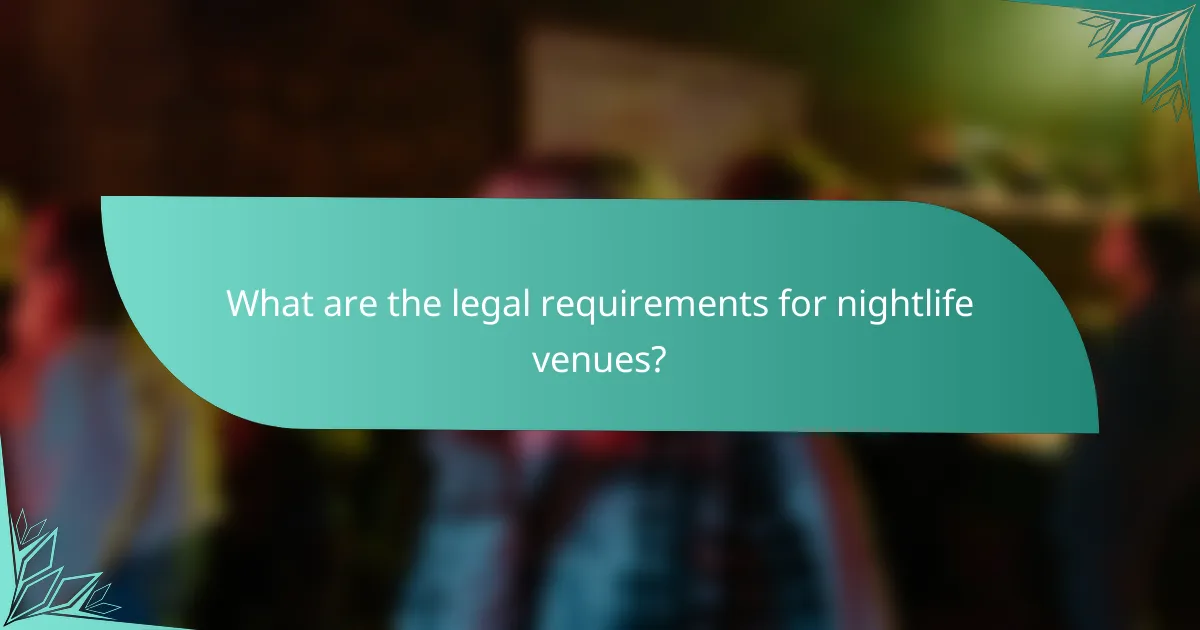
What are the legal requirements for nightlife venues?
Nightlife venues must adhere to various legal requirements to operate safely and responsibly. These include obtaining necessary licenses and permits, complying with health and safety regulations, and maintaining adequate insurance coverage.
Licensing and permits
Licensing and permits are crucial for nightlife venues to legally serve alcohol, host events, and ensure public safety. Venues typically need a liquor license, which may vary by state or city, and can require applications, fees, and background checks.
Additionally, venues may need permits for live entertainment, outdoor seating, or special events. It’s essential to check local regulations to ensure compliance and avoid fines or shutdowns.
Health and safety regulations
Health and safety regulations are designed to protect patrons and staff in nightlife venues. This includes maintaining proper sanitation, ensuring fire safety measures are in place, and adhering to occupancy limits.
Venues should conduct regular safety inspections and staff training on emergency procedures. Compliance with local health codes, such as food handling and cleanliness standards, is also critical to avoid health violations.
Insurance requirements
Insurance is a key legal requirement for nightlife venues, protecting against potential liabilities. Common types of insurance include general liability, liquor liability, and property insurance, which cover various risks associated with operating a venue.
It’s advisable for venue owners to consult with an insurance professional to determine the appropriate coverage levels based on their specific operations and local regulations. This can help mitigate financial risks from accidents or incidents that may occur on-site.
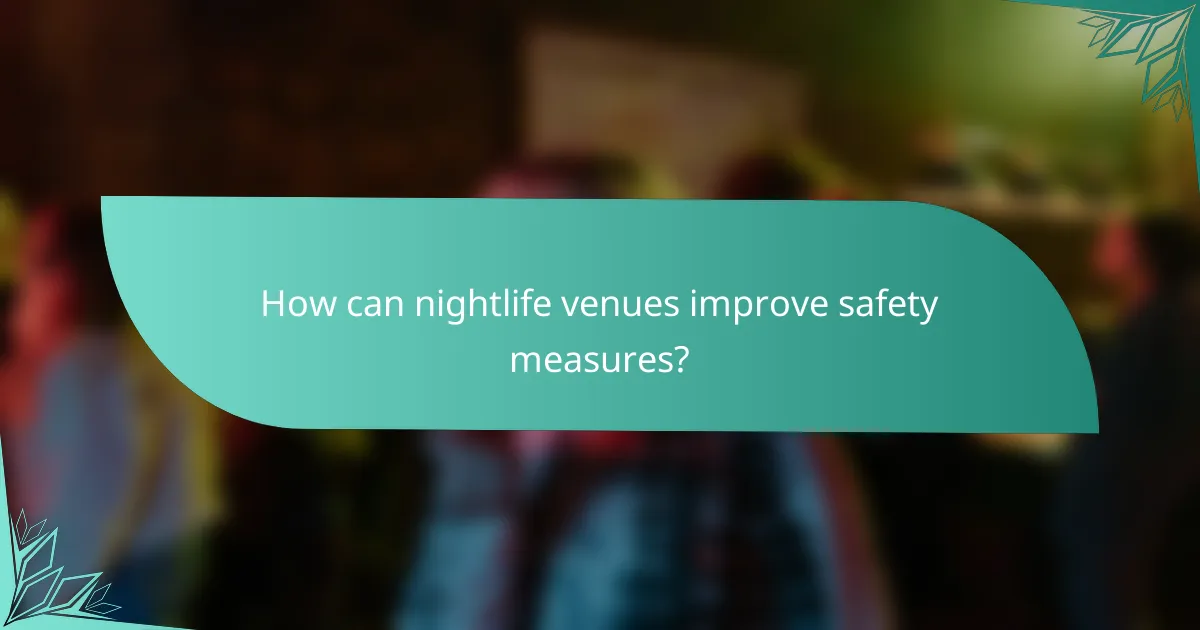
How can nightlife venues improve safety measures?
Nightlife venues can enhance safety measures by implementing comprehensive protocols, staff training, and effective communication systems. These strategies not only protect patrons but also create a secure environment that fosters a positive experience.
Staff Training and Awareness
Training staff on emergency response procedures is crucial for ensuring safety in nightlife venues. Regular drills and workshops can prepare employees to handle various situations, such as medical emergencies or disturbances. This proactive approach helps staff act quickly and efficiently when incidents occur.
Additionally, educating staff about recognizing signs of intoxication or distress in patrons can prevent potential issues before they escalate. Empowering employees to intervene appropriately fosters a culture of safety and responsibility.
Emergency Response Plans
Developing a clear emergency response plan is essential for nightlife venues. This plan should outline specific procedures for different types of emergencies, including fire, medical incidents, and security threats. Having a written plan ensures that all staff members know their roles and responsibilities during a crisis.
Regularly reviewing and updating the emergency response plan is vital to accommodate any changes in venue layout or local regulations. Conducting drills can help identify gaps in the plan and improve overall preparedness.
Collaboration with Local Authorities
Building strong relationships with local emergency services can significantly enhance safety measures in nightlife venues. Establishing communication channels with police, fire departments, and medical services ensures a coordinated response during emergencies. Regular meetings can facilitate information sharing and improve response times.
Additionally, venues can invite local authorities to conduct safety assessments, which can provide valuable insights into potential risks and necessary improvements. Collaborating with these agencies can also help venues stay informed about local regulations and best practices.
Surveillance and Security Systems
Implementing surveillance and security systems is a key component of improving safety in nightlife venues. High-quality cameras can monitor both the interior and exterior of the venue, deterring criminal activity and providing evidence in case of incidents. Security personnel should be trained to monitor footage and respond to any suspicious behavior.
Moreover, investing in access control systems can help manage entry points and ensure that only authorized individuals are allowed inside. This can reduce the likelihood of altercations and enhance overall patron safety.
